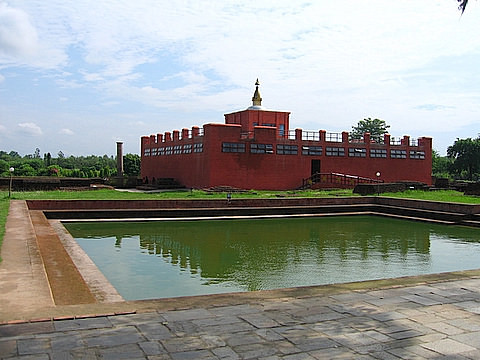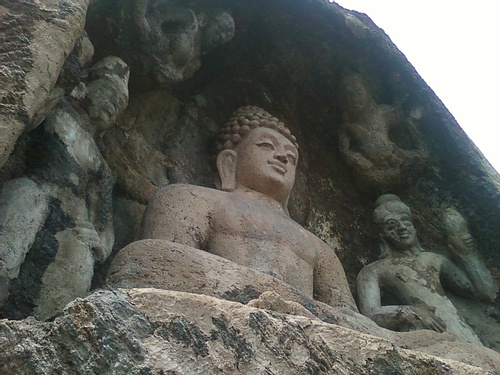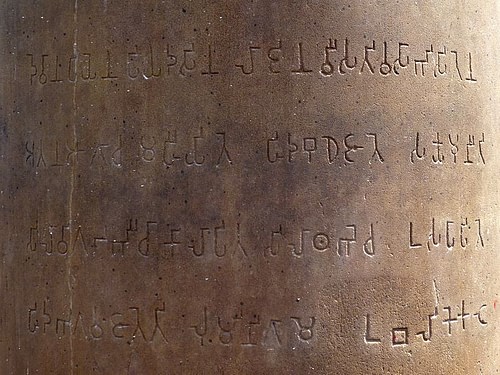
Lumbini is a village, archaeological site, and place of pilgrimage honored as the birthplace of Siddhartha Gautama (the Buddha, l. c. 563-483 BCE) located in modern-day Rupandehi District of Nepal, Province 5, near the Indian border. It was first formally identified as the Buddha's birthsite in 249 BCE by the Mauryan king Ashoka the Great (r. 268-232 BCE).
Prior to Ashoka's visit, the village was known by another name, perhaps similar but now lost, and was already an important pilgrimage site for adherents of the early Buddhist schools. It seems to originally have been a landscaped pleasure garden located between the cities of Kapilavastu, to the east, and Devadaha, to the southwest, ruled, respectively, by the clans of the Shakya and Koliya, who were related by blood. Suddhodana, of the Shakya, married his cousin Maya, of the Koliya, who would become the mother of the Buddha.
According to the accounts in Buddhist and Jaina texts, Maya was traveling from Kapilavastu to her home city of Devadaha to give birth when she stopped to rest in the gardens of Lumbini and went into labor. She gave birth to her son beneath a Sala tree and, according to some versions of the story, bathed him in a nearby pond. She seems to have then returned to Kapilavastu where she died seven days later.
Her son would later renounce his heritage to follow a path of spiritual asceticism, eventually attaining enlightenment and becoming the Buddha (“awakened one”), founder of Buddhism. He taught others his vision for the next 45 years, and after his death, his disciples continued his teachings through the establishment of various schools of thought and honored the sites associated with Buddha's life by designating them sacred places of pilgrimage and erecting stupas containing his relics.
The site seems to have been deserted after the Shakya clan was defeated and nearly annihilated by the Kingdom of Kosala (c. 7th-5th centuries BCE) under their king Vidudabha (c. 6th century BCE) of the Baghochia Dynasty. It remained an important place of pilgrimage, however (evidenced by modern-day archaeological evidence), and continued to be honored as the birthplace of the Buddha up through 249 BCE when Ashoka visited and erected his famous pillar which established the site's name. Afterwards, many pilgrims made long, arduous treks to Lumbini to honor the Buddha.
Among these was the Chinese monk Seng-Tsai (l. 265-420 CE), the first foreign visitor to record a detailed description, and later by the pilgrims Faxian (l. 337 - c. 422 CE) and Xuanzang (l. 602-644 CE), but the popularity of the site waned, and it was again deserted in the 9th century CE when the region was fought over by the invading Muslims and defending Hindus. The site may have still been visited by local people but was forgotten until it was rediscovered in 1896 CE and excavations began. It has remained one of the most popular Buddhist pilgrimage sites in the world since the early 20th century CE and was declared a UNESCO World Heritage Site in 1997 CE.
Legendary History & Birthplace of Buddha
According to Buddhist texts, the city of Kapilavastu (and possibly Devadaha) was founded by the legendary king Ikshvaku who established the Ikshvaku Dynasty. He was one of the sons of Shraddhadeva Manu, the first human who, according to Hindu belief, was warned of the Great Flood by the god Vishnu, built a large boat which saved his family, planted seeds and animals, and the seven patriarchs (saptarishi), and afterwards became the progenitor of humanity.
Ikshvaku engaged in numerous building projects, cultivating the land – perhaps even the garden of Lumbini, though this is speculative – and established the dynasty associated with the later Shakya clan. He is identified with the Shakya king Okkaka, first chief (or king) of the Shakya clan, and their relatives, the Koliya. Kapilavastu and Devadaha were ruled by two brothers of these clans: Sihahanu and Anjana, respectively. The cities enjoyed friendly relations and were allied through intermarriage, which kept the bloodline pure.
The most famous of these marriages was between Suddhodana of the Shakya clan of Kapilavastu (eldest son of Sihahanu) and Maya of the Koliya clan of Devadaha (daughter of Anjana). Although the Buddhist texts routinely present Suddhodana as a king, descended from a long line of royalty, modern scholarship suggests he was more of a regional governor or administrator, though still of the upper class, and belonging to the kshatriya (warrior) caste. The Shakya's political system was an oligarchy (in which one is elected to the ruling assembly), not a monarchy (where rule is passed from father to son or another relative) so it is most likely that Suddhodana was more of a high-caste elected official than a prince or king.
Lumbini, it would seem, was already well-established by the time Suddhodana married his cousin Maya. For reasons which are unclear, they did not have any children for the first 20 years of their marriage. One night, though, Maya had a dream in which she was carried away by four good spirits who bathed and purified her in a lake (or pond), then dressed, anointed, and honored her with garlands of flowers. A white elephant then appeared, circled her three times, and entered her womb through her right side. When Maya woke up the next morning, she knew she was pregnant with her first child.
In time, as tradition mandated, she left Kapilavastu with an entourage to give birth in her home city of Devadaha. They stopped at Lumbini for Maya to rest and bathe, and after her bath in the pond there, she was walking through the gardens when she went into labor and gave birth to Siddhartha while holding onto a branch of a Sala tree. Siddhartha is said to have stood up, taken seven steps toward the north, and announced himself as the bringer of peace, also stating that this would be his last incarnation. According to some versions of the legend, Maya then bathed her newborn in the nearby pond (establishing a ritual still observed to the present) while in others, a sudden rain washes him clean and, in others, he is bathed by the same spirits who appeared to Maya in her dream.
The entourage then seems to have returned to Kapilavastu where it was prophesied that the newborn would grow up to become either a great ruler or significant spiritual leader. Maya died seven days after her son's birth and he was raised by his maternal aunt, Prajapati, whom Suddhodana took as his second wife.
Buddha Legend & Ashoka
According to the legend of the early life of the Buddha, upon hearing the prophecy concerning his son, Suddhodana took measures to protect him from any knowledge of suffering - which might inspire him to devote his life to spirituality - by building a compound at Kapilavastu which separated Siddhartha from the outside world for the first 29 years of his life. Eventually, though, these defenses failed, and the young man was exposed to the concepts of sickness, age, and death, which set him on a course of ascetic discipline finally resulting in his enlightenment.
As the Buddha, he taught for 45 years and, before his death, is said to have suggested to his disciples that, in the future, four sites should be designated as places of pilgrimage for his followers; first among these was Lumbini, his birthplace. Excavations at the site have established a continuity of pilgrimage there from around the 6th century BCE, which seems to have been interrupted when the Shakya clan was nearly annihilated by their overlords of the Kingdom of Kosala. Pilgrimage resumed and grew in popularity during the reign of Ashoka the Great who established Lumbini formally and provided the name it has been known by since.

Ashoka converted to Buddhism sometime after his victory over the Kingdom of Kalinga c. 260 BCE. The Kalinga war was so devastating to the vanquished that, even though he had won, Ashoka was filled with remorse and renounced violence, embracing Buddhism. In 249 BCE, he visited Lumbini with an entourage which included his spiritual advisor and decreed a sandstone pillar be erected at the site to honor it and commemorate his visit. His inscription on the 22-foot tall pillar, in Brahmi and Pali script, reads:
King Piyadasi, Beloved of the gods [Ashoka], having been consecrated as king twenty years, came himself here personally to offer homage and celebrate because Shakyamuni Buddha was born here. [I caused a pillar and monument to be set up] and, because the Lord was born here, the Lumbini village was made free from taxes and liable only for one-eighth of the produce. (Lumbini Pillar, 1)
Ashoka also decreed edicts be inscribed on rocks, pillars, and on other free-standing monuments throughout his territory encouraging Buddha's vision and sent missionaries to other countries. Buddhism flourished in nations such as Sri Lanka, China, Korea, and Thailand, becoming much more popular than it was in its homeland and attracting foreign pilgrims to sites such as Lumbini. Among these were the Chinese pilgrims Seng-Tsai, Faxian, and Xuanzang whose works have become famous for the detailed accounts of their respective journeys in c. 350-375, 399, and 627 CE.
Prominence & Loss
Seng-Tsai's account is the first to record the lapis lazuli sculpture of Queen Maya Giving Birth to the Buddha as well as the stone slab which marked where the Buddha took his first steps on earth (both still preserved at the modern-day site). The sculpture of Maya giving birth beneath the Sala tree, according to Seng-Tsai, was erected beneath the descendant of the original tree. The site at this time (c. 350-375 CE) seems to have been well-cared for and popular with pilgrims.
Faxian's work (The Record of Faxian or A Record of Buddhistic Kingdoms) would serve “as an authoritative guidebook for many pilgrims who followed in his footsteps” (Buswell & Lopez, 298) and preserved many of the legends associated with Lumbini and the Buddha's birth. Faxian writes:
East from the city [of Kapilavastu] lies a garden, named Lumbini, where the queen [Maya] entered the pond and bathed. Having come forth from the pond on the northern bank, after [walking] twenty paces, she lifted up her hand, laid hold of a branch of a tree, and, with her face to the east, gave birth to the heir apparent. When he fell to the ground, he immediately walked seven paces. Two dragon kings appeared and washed his body. At the place where they did so, there was immediately formed a well and, from it, as well as from the above pond where Maya bathed, the monks even now constantly take the water and drink it. (Chapter 22)
Faxian's account also provides evidence that the site was still a popular pilgrimage destination and that rituals were regularly observed there.

Xuanzang defied the imperial edict of the Tang Dynasty emperor Taizong (r. 626-649 CE) against foreign travel to embark on his quest in 627 CE. Xuanzang's work is well known for his translations of Buddhist texts into Chinese (especially the Heart Sutra from Perfection of Wisdom) but he also took detailed notes on the sites he visited. At Lumbini, he records damage to Ashoka's pillar and other monuments, noting how many of the structures were in poor condition.
Xuanzang's account, and a lack of other records or evidence of pilgrimage to the site at this time, suggests that Lumbini's popularity flagged at some point. This could simply be because Buddhism was not as popular in India as it came to be in other countries or because of a resurgence in the popularity of Hinduism. The Muslim invasions of the 9th and, especially, 12th centuries CE resulted in the destruction of many Hindu, Jain, and Buddhist sites and, at this time, Lumbini seems to have been deserted and eventually was forgotten except by locals.
Rediscovery & Development
The rediscovery of Lumbini has been routinely attributed to the German archaeologist Alois Anton Fuhrer (l. 1853-1930 CE) but this has been challenged, with good reason. The site was actually first identified by the former military commander and then-regional governor Khada Shamsher Jang Bahadur Rana (served in office 1885-1887 CE) in 1896 CE. Khada Shamsher was told of the discovery of an ancient pillar, mostly buried in the earth, reported the object to the Irish Indologist Vincent Arthur Smith (l. 1843-1920), who was serving in an administrative position for the British in the region, and then sent Nepalese workers to excavate. Vincent Arthur Smith was already aware that Lumbini existed somewhere in the region but did not know precisely where until he was told of Khada Shamsher's discovery so Fuhrer's claim to have discovered the site, so often repeated, is untenable.
Alois Anton Fuhrer was, at this time, working in the region elsewhere – though he may have done some work earlier around Lumbini – and hurried to the site where he then claimed to have discovered Ashoka's pillar. By the time he got there, however, the pillar had been completely cleared by Khada Shamsher's workers. Shortly after announcing his amazing discovery of Lumbini, Fuhrer was charged by Vincent Arthur Smith with creating fake artifacts and submitting false reports to Sir Alexander Cunningham (l. 1814-1893 CE), founder of the Archaeological Survey of India which was in charge of excavations, historical preservation, and antiquities.
Fuhrer admitted to his crimes, resigned in 1898 CE, and left the country, handing his position over to the Indian archaeologist Purna Chandra Mukherjee (also given as P.C. Mukherjee or Mukherji, l. c. 1845-1903 CE). Mukherjee had joined Cunningham's organization in 1883 CE but, as most of his colleagues were white Europeans, was not given a great deal of opportunity to excavate. He was working on locating Kapilavastu when Fuhrer was disgraced and he then took over the excavations at Lumbini in the 1898-1899 CE season.
If anyone deserves credit for “discovering” Lumbini, it is Mukherjee who was the first to engage in careful and extensive work at the site, uncovering temples, sculptures, and other structures as well as correcting the dates suggested by Fuhrer. Mukherjee's work set the standard for excavation at Lumbini which, unfortunately, would not be adhered to by later work at the site. Between 1933-1939 CE, extensive restoration work was ordered at Lumbini by the governor of the region to make it a more attractive tourist attraction. It is unknown what may have been lost at this time, but the major work of Mukherjee was preserved.
Conclusion
The Nepalese Department of Archaeology took over the site shortly afterwards, and it then came under the protection of the Ancient Monument Preservation Act of 1956 CE. In the present day, Lumbini is under the care of the Lumbini Development Trust, a non-profit organization, which manages the site. In its present form, Lumbini is 3 miles (4.8 km) long and 1.0 mile (1.6 km) wide with an expansive monastic center separated by a large canal into zones for the Theravada and Mahayana schools of Buddhism and their temples on each side of the water.
The Mahadevi Temple, Ashoka's pillar, and other sacred sites are all open to the public and, in 2013 CE, excavations in the Mahadevi Temple by British archaeologist Robin Coningham revealed a wooden structure beneath it dating from the 6th century BCE, the oldest Buddhist shrine in the world, which once seems to have enclosed a tree. The significance of this, of course, is the link between the Sala tree and Buddha's birth and it is thought that the Mahadevi Temple's site developed from this earlier shrine.
Many different nations from around the world have erected structures at Lumbini honoring the vision of the Buddha and committing themselves to the prospect of world peace and cooperation. Lumbini is among the most popular pilgrimage and tourist attractions in Nepal, and, although it no doubt looks vastly different today than it did in the time of the Buddha, it is claimed to emanate the same peace and tranquility which his mother is said to have experienced over 2,000 years ago when she stopped there to walk among the gardens.






